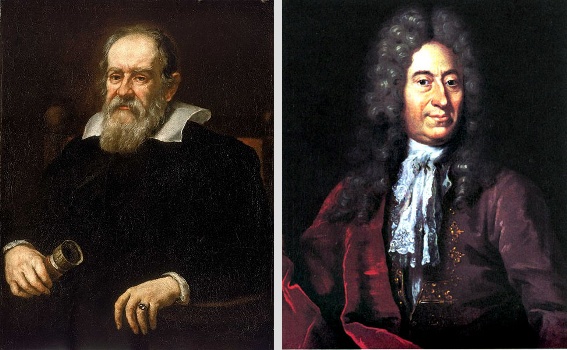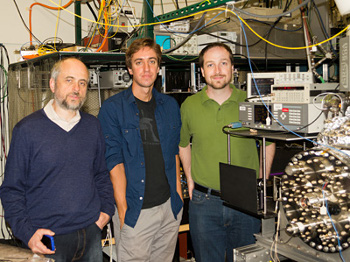The Speed of Light
August 16, 2013
Everyone hates
speed limits. I understand and tolerate the 65 mile-per-hour speed limit on most
US interstate highways, since it allows a measure of safety against driver
reaction time. What I don't tolerate are those stretches of local road where I'm sure the artificially low speed limit was set merely to
generate revenue.
Legislated speed limits can be changed, but there's no getting around the universal speed limit, the
speed of light, commonly symbolized as
c. Even the proverbial "speeding bullet" in the introduction of the
Adventures of Superman television series (
one or two thousand miles per hour) pales in comparison with the speed of light, 186,000
miles-per-
second (300,000
kilometers-per-second).
The speed of light is so rapid that it appears to be
infinite, but one argument by the
ancient Greek philosophers for an infinite speed of light seems especially strange today.
Euclid and
Ptolemy thought that the process of
vision involved
light emanating from the
eyes and
reflecting back to the observer. From this idea,
Hero of Alexandria reasoned that the speed of light must be infinite, since we instantly see distant objects, such as
stars, when we open our eyes. I wrote about Hero in a
previous article (Steam Power, January 28, 2011).
Through the time of
Kepler (c. 1600), all arguments about the speed of light were merely
philosophical. As
Bernd Matthias demonstrated in the field of
superconductivity,[1] one good
experiment is worth a hundred
theoretical papers, so
Galileo performed an experiment in 1638 to measure the speed of light using
signal lanterns separated by a large distance. He concluded that the speed was either very rapid or instantaneous. The round trip transit time of light over a mile's distance is just 10.73
microseconds.

Galileo Galilei (left), who did the first speed of light experiment in 1638, and Ole Rømer, who used a natural satellite of Jupiter as a clock to estimate the speed of light in 1676. (Source images, left, portrait of Galileo Galilei, 1636, by Justus Sustermans (1597–1681), at the National Maritime Museum, Greenwich, London; and, right, portrait of Ole Rømer, circa 1700, by Jacob Coning (circa 1647–1724), at the Frederiksborg Museum, both via Wikimedia Commons)
The
Danish astronomer,
Ole Rømer, was the first to actually affix a quantity to the speed of light. He did this by noticing that the period of
Jupiter's moon,
Io, was shorter when the
Earth was approaching Jupiter, and longer when receding from it. Rømer's estimate was 220,000 kilometers/sec, about 75% of the established value. A more accurate astronomical measurement was made in 1729 by
English astronomer,
James Bradley, who used his discovery of the
aberration of light to calculate its speed to within 1.5% of its established value.
Since 1983, we are privileged to know the
exact value of the speed of light. This value, 299,792.458 kilometers/sec was fixed by
a new definition of the meter. Now, any improvement in the measurement of the speed of light is actually an improvement in the definition of the
meter. That being said, everyone still uses the 300,000 kilometers/sec value. As my
building contractor father would say when
surveying for the
foundation of a house, "It's close enough for digging."
Since the speed of light is a fundamental quantity and a part of the
equations of so many theories, it's still studied. Earlier this year I reported on the possibility that the speed of light we measure is an
average value. It might show variation over very short length scales (
Light Speed, April 8, 2013).
There was brief excitement among
physicists at the end of 2011, with a report that some
neutrinos might travel faster than light. This discovery was made during operation of the
OPERA experiment in which a beam of
muon neutrinos is sent to a
detector 730 km (453 miles) away. A small fraction of these seemed to arrive 60
nanoseconds sooner than expected for light speed, as I reported in a
previous article (Tachyons, September 26, 2011). This result was
found to be erroneous, the consequence of a loose
optical cable.
Large instruments such as the
Large Hadron Collider at
CERN are not required to do meaningful speed of light measurements, as an international team of physicists from the
University of California, Berkeley, and the
University of New South Wales,
Sydney, Australia have shown.[2-5] The results of their
laboratory experiment showed that the maximum speed of
electrons traversing from one
atomic orbital to another, which should be the speed of light, is the same in all directions to within 17
nanometers per second.[4] This is consistent with a
general relativity principle called
Lorentz invariance.[5] Their experiment is published in
Physical Review Letters.[4]

The Budker Group of the Berkeley Physics Department.
Left to right, Dmitry Budker, Nathan Leefer and Michael Hohensee. They are posing with their experimental apparatus.
(UCLA Berkeley photo by Andreas Gerhardus.)
The experiment studied the
energy required to change the
velocity of electrons in transitions from one atomic orbital to another in
dysprosium. Dysprosium has a pair of orbitals very close in energy for which the electrons travel at different speeds, so small changes in the electron
kinetic energy can be detected.[5] The electron orbitals of the
atoms were partially aligned by the
polarization of the exciting
laser beams, so the
rotation of the Earth was equivalent to sampling the electron velocity in different directions of
space.[5] The measurements were an
order of magnitude more sensitive than previous studies.[4-5]
The dysprosium atoms functioned as
atomic clocks having a relative
frequency difference. It was found that in a two year period in which the Earth's distance to the
Sun changed, the relative frequency of the clocks was constant. This finding was consistent with the local position invariance of general relativity that the kinetic energy of an object is independent of its location in a
gravitational field.[4-5]
Berkeley physics
postdoc, Michael Hohensee, summarized his motivation for such experiments by saying,
"As a physicist, I want to know how the world works, and right now our best models of how the world works – the Standard Model of particle physics and Einstein's theory of general relativity – don't fit together at high energies... By finding points of breakage in the models, we can start to improve these theories."[4]
The speed of light isn't the only important
constant in physics. I've written about the
fine structure constant in a
previous article (Fine Structure Constant, September 16, 2010). This constant, which is quite close to the
reciprocal of 137 (~1/137.036), expresses the strength of the interaction of
charged particles, so it's fundamental to
electromagnetism. Its value is in agreement with
theory to eleven decimal places.
The fine structure constant is related to some rather fundamental things; namely, the
elementary charge e,
Planck's constant h, the
speed of light c and the mathematical constant
π,
α = (2 π e2)/(h c)
where
α is the
dimensionless fine structure constant. So, if
α changes, is it because
e,
h or
c changes? Any such changes would be notable.
The research team was able to adapt their experiment to perform the same measurements for the fine structure constant. Their results, accepted for publication in Physical Review Letters and available online at
arXiv,[6] show that the fine structure constant does not vary with time or gravitational field.[5-6] Their result for the time change of
α was (1/α)(∂α/∂t) = (-5.8±6.9)×10
-17 yr
-1, consistent with zero.[6]
The experimental results, although impressive, were not optimized. The present order of magnitude improvement over past measurements is expected to reach three orders of magnitude in the future.[2-3,5] If there's some secret hiding in
c or
α, it might be found in the next few years. This research was funded by the
National Science Foundation, the
Australian Research Council, and other agencies.[4]
References:
- T. H. Geballe And J. K. Hulm, "Bernd Theodor Matthias (June 8, 1918-October 27, 1980)," Biographic Memoirs Volume 70 (1996), National Academies Press, ISBN 978-0-309-05541-3, 448 pages.
- M. A. Hohensee, N. Leefer, D. Budker, C. Harabati, V. A. Dzuba and V. V. Flambaum, "Limits on Violations of Lorentz Symmetry and the Einstein Equivalence Principle using Radio-Frequency Spectroscopy of Atomic Dysprosium," Phys. Rev. Lett., vol. 111, no. 5 (August 2, 2013), Document No. 050401 [5 pages].
- M. A. Hohensee, N. Leefer, D. Budker, C. Harabati, V. A. Dzuba and V. V. Flambaum, "Limits on violations of Lorentz symmetry and the Einstein equivalence principle using radio-frequency spectroscopy of atomic dysprosium," arXiv Preprint Server, March 17, 2013.
- Robert Sanders, "Quest to test Einstein's speed limit," University of California, Berkeley, Press Release, July 29, 2013.
- Marcus Woo, "Focus: Testing Relativity Using Earth's Motion," Physics, vol. 6, no. 84 (July 29, 2013), DOI: 10.1103/Physics.6.84.
- N. Leefer, C. T. M. Weber, A. Cingöz, J. R. Torgerson and D. Budker, "New limits on variation of the fine-structure constant using atomic dysprosium," arXiv Preprint Server, April 25, 2013.
Permanent Link to this article
Linked Keywords: Speed limit; US Interstate Highway System; reaction time; speed limit enforcement; revenue generation; speed of light; Adventures of Superman; television series; mile; kilometers-per-second; infinity; infinite; ancient Greek philosophy; ancient Greek philosopher; Euclid; Ptolemy; visual perception; vision; light; eye; reflection; reflecting; Hero of Alexandria; star; Kepler; philosophy; philosophical; Bernd T. Matthias; superconductivity; experiment; theory; theoretical; scientific literature; paper; Galileo Galilei; signal lantern; microsecond; Ole Rømer; natural satellite; Jupiter; clock; Justus Sustermans (1597–1681); National Maritime Museum; Greenwich, London; Jacob Coning; Frederiksborg Palace; Frederiksborg Museum; Wikimedia Commons; Denmark; Danish; astronomer; Io; Earth; English people; English; James Bradley; aberration of light; history of the meter; definition of the meter; meter; general contractor; building contractor; surveying; foundation; equation; average; physicist; neutrino; OPERA experiment; muon neutrino; neutrino detector; nanosecond; Faster-than-light neutrino anomaly; optical cable; Large Hadron Collider; CERN; University of California, Berkeley; University of New South Wales; Sydney, Australia; laboratory; electron; atomic orbital; nanometer; general relativity; Lorentz covariance; Lorentz invariance; Physical Review Letters; Budker Group; Berkeley Physics Department; Dmitry Budker; Nathan Leefer; Michael Hohensee; Andreas Gerhardus; energy; velocity; dysprosium; kinetic energy; atom; polarization; laser; rotation of the Earth; space; order of magnitude; atomic clock; frequency; Sun; gravitational field; postdoctoral research; postdoc; Standard Model; particle physics; Albert Einstein; physical constant; fine structure constant; multiplicative inverse; reciprocal; electric charge; elementary particle; electromagnetism; quantum electrodynamics; Planck's constant; dimensionless quantity; arXiv; National Science Foundation; Australian Research Council; T. H. Geballe And J. K. Hulm, "Bernd Theodor Matthias (June 8, 1918-October 27, 1980)," Biographic Memoirs Volume 70 (1996), National Academies Press, ISBN 978-0-309-05541-3, 448 pages.